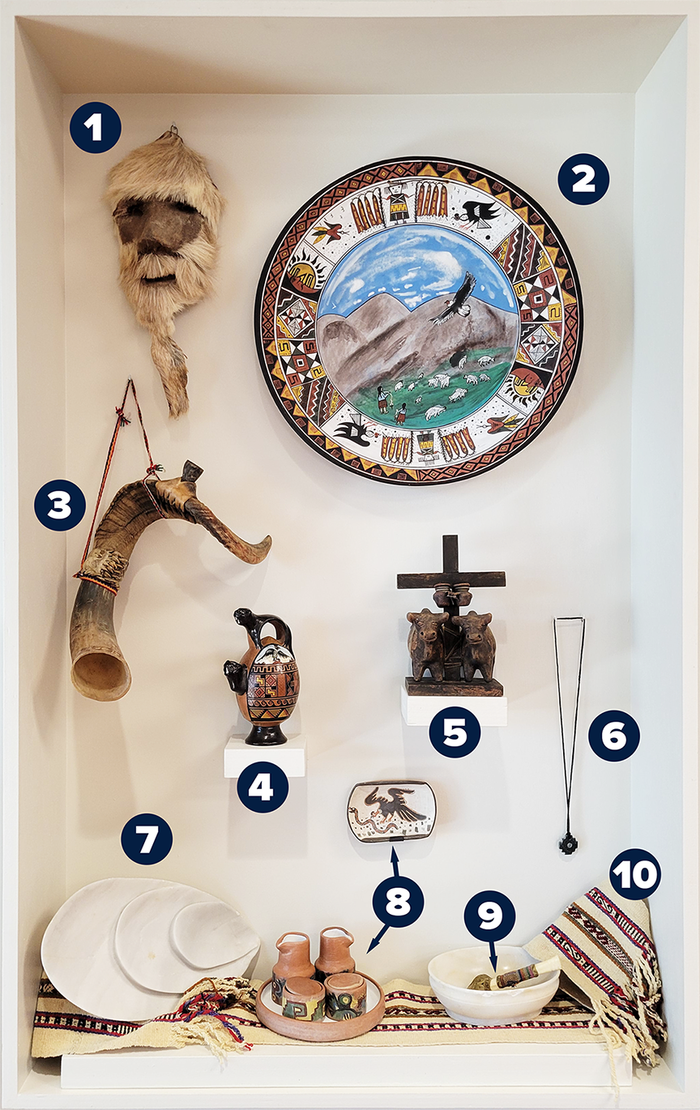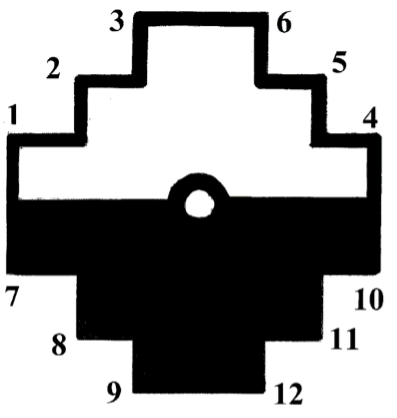“Visiting new lands through study abroad trips proved as exciting for me as it was for my students. In my seven trips to Peru, we delved into the Incan culture, exploring and learning from its fascinating history.
Throughout the journey, I encouraged my students to collect indigenous art, pieces that evoke something new within while providing a keepsake to share and inspire others. Over the years, I collected many artifacts that piqued my interest, like those represented in this shadow box.
After each trip, my students would come to understand that they may empty their suitcases, but they will be unpacking their newfound perspective and treasured memories for years to come.
I hope these artifacts stimulate a curiosity and desire to explore the world through our study abroad programs. Wishing you amazing adventures and safe travels!”
– Mike Krajsa
Peruvian Artifacts
The display can be found in the Welcome Center.
1. This unique molded alpaca fur/ leather face scrapping was crafted in the Urubamba region where artisans work making a variety of traditional leather goods
2. In ancient Peru, pottery had practical, ceremonial and religious purposes. For that reason, ceramic were often elaborately decorated or made to represent important human figures or animals. The large platter featuring numerous Incan symbols like the mountain, Apu, and the condor was crafted and hand painted in a village that has a co-op of over 80 potter families that have been working together for over 100 years. All the clay pottery is raku like fired around outdoor fire using century old practices. In the ancient religion and mythology of Peru, Ecuador, and Bolivia, an Apu is the term used to describe the spirits of mountains and sometimes solitary.
3. The Incans used this combined cow and ram horn to communicate with the different outposts along the Incan trail from Cusco to Machu Picchu. Before the Spaniards invaded, they used smoke signals, which would have given away their fortification positions to the enemy.
4. The ceramic painted pitcher featuring a Puma handle and hand paintings of the condor and other Incan symbols was used in many traditional Incan ceremonies. It is also used to serve Chicha, a fermented corn liquor, which has a long historical significance. In times of warfare, the Incas would take the decapitated skull of their enemies and turn them into a drinking vessels for Chicha. This ceremonial process of drinking Chicha from the head of a foe symbolized the successful transformation from the disorder of warfare to the order of the Incan Empire
5. The bulls and cross, known as Torito de Pucara, are placed on the roof for good luck, fertility (of crops and livestock) and to bring prosperity. They are typically given as presents for extra luck and pretty much every building you see in southern Peru has one of the decorations on the highest point if its roof. In consider the bull a symbol of fertility. When Catholicism came to Peru, the cross was added.
6. The most symbolic representation and embodiment of Incan culture is the Incan Cross hanging on the string.
- The lower world (Uqhu Pacha) represented the underworld and death
- The middle world (Kay Pacha) represented the world of human life
- The upper world (Hanan Pacha) included the stars, celestial beings and gods
- the snake, living underground, represented the lower world
- the puma, a powerful land animal represented the middle world
- the condor represented the upper world in the sky
- don’t steal
- don’t lie
- don’t be lazy
- love and well doing
- knowledge
- work
7. The white 3 tiered platter and carved bowl are from Ayacucho, a region at 9,000 feet in the Andes famous for its intricate carvings of Humana stone, an indigenous form of white alabaster. The Nittany Lion was commissioned and carved here as well.
8. The ceramic small dish featuring two prominent Incan symbols, the condor and culebra (snake), along with the pottery table set below are examples of their ceramic artistry from the Sacred Valley.
9. The carved and decorated pipe is used in various Incan ceremonies such as Ayahuasca. Ayahuasca is a South American psychoactive and entheogenic brewed drink traditionally used both socially and as a ceremonial or shamanic spiritual medicine among the indigenous peoples of the Amazon basin.
10. The scarf was woven of Alpaca from the village of Cachuma where students built over 20 green houses with Heifer International and other NGOs over several trips to Peru.

